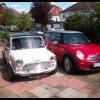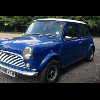In the 1960's car buyers still had great loyalty to their favourite British car marques and local dealerships and this continued even when many of these independent British car companies were swallowed up and merged together under BMC (British Motor Corporation). To allow dealers like Austin and Morris who had been competing against each other (often in the same town) to remain trading under BMC ownership, the new BMC cars were often 'badge engineered' to retain these customer and dealer loyalties, even though the cars were often identical apart from a few minor trim differences........or sold at a higher price if the badge was from an upmarket brand like Woleseley or Riley (eg. Hornet/Elf).
As the years went by Austins were sometimes produced at Morris factories and vice-versa depending on resources and demand, labour strikes, etc.
This internal rivalry and inhouse competition and lack of rationalisation of the model range is often cited as part of the eventual downfall of BMC/BL.
For the 1970's BL decided to drop the Austin and Morris branding from the Mini range in the home and most export markets, so with the launch of the Mk3 Mini in late 1969, 'Mini' became a standalone brand (although many were still registered by dealers as Austin or Morris) and continues to be just Mini or MINI under BMW's ownership today.
Todays car manufacturers continue to 'badge engineer' with many modern cars using and sharing the same chassis platforms and common components and engines to reduce costs but with different sheet metalwork/body styling rather than just minor trim variations like BMC mostly offered.
eg. VW-Audi-Skoda-Seat model ranges.
Edited by mab01uk, 07 August 2014 - 09:01 AM.

















